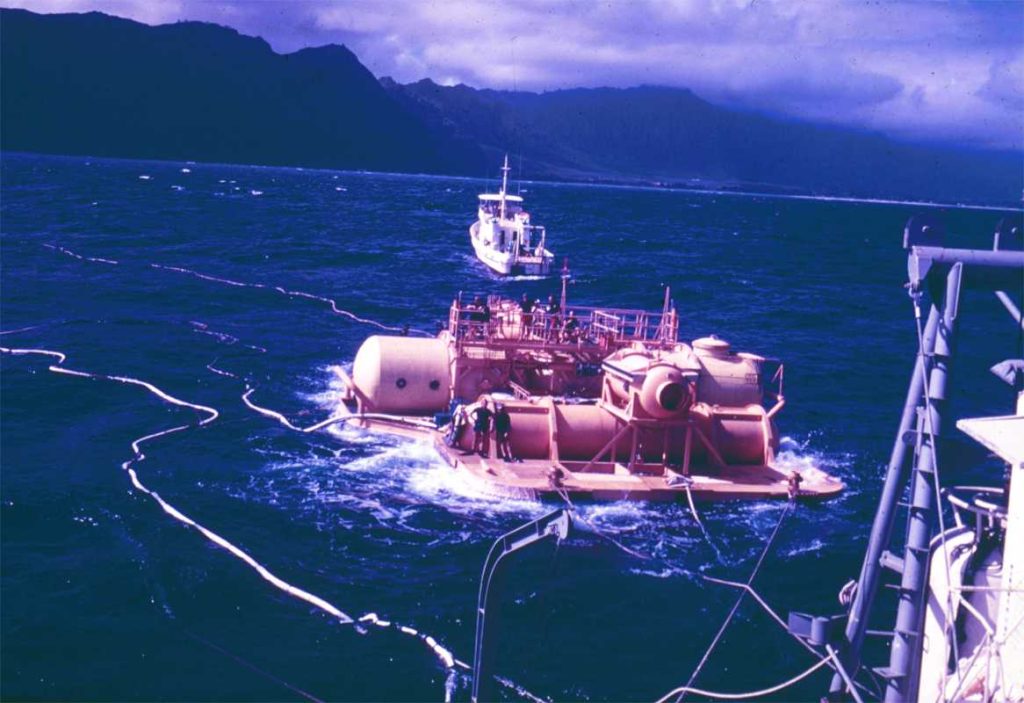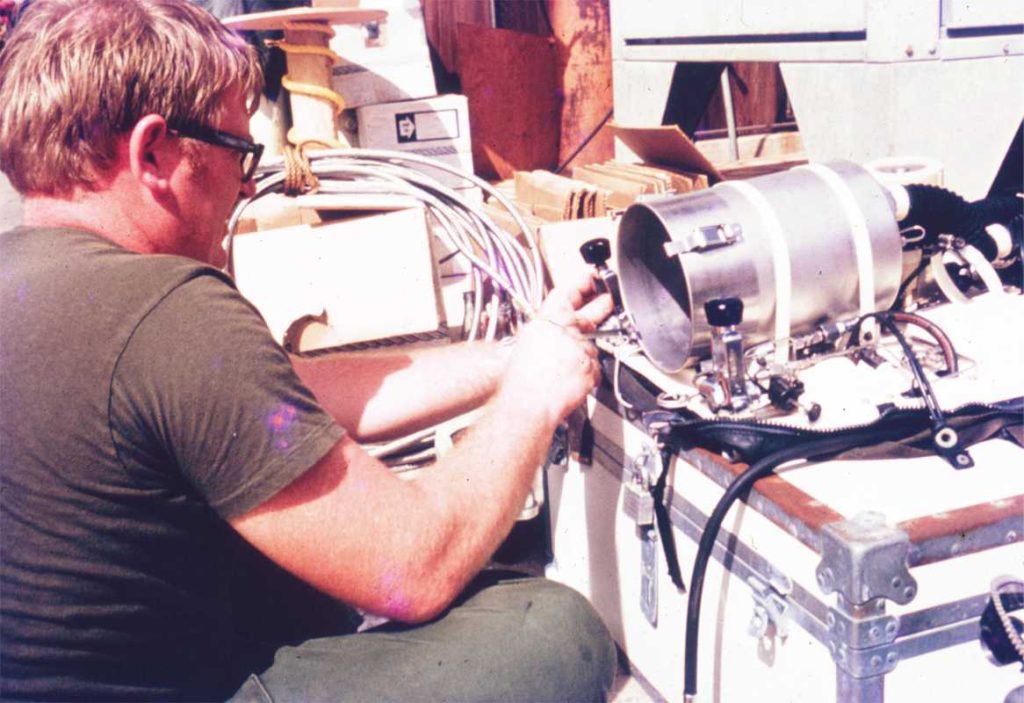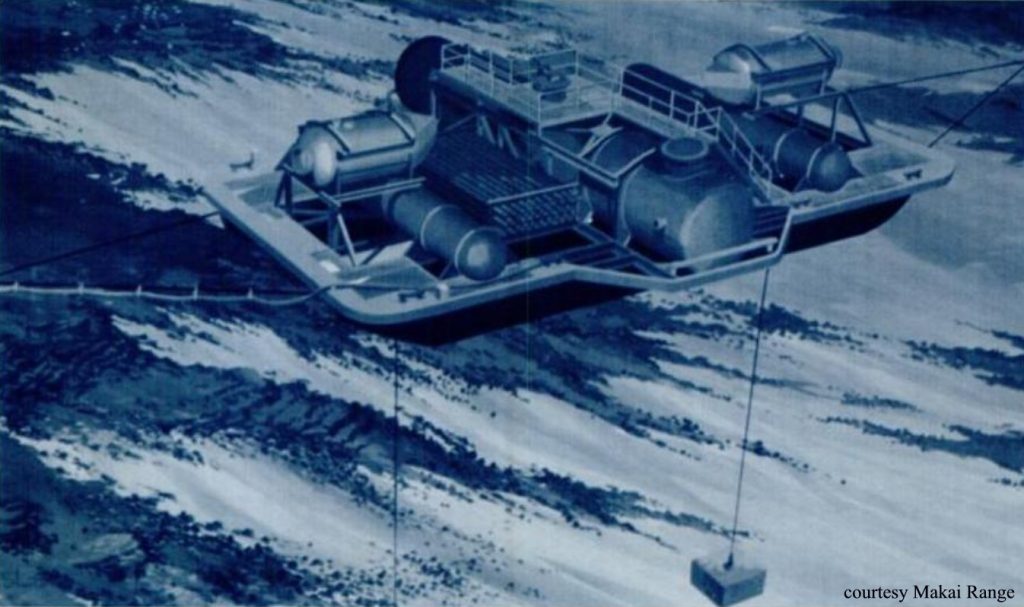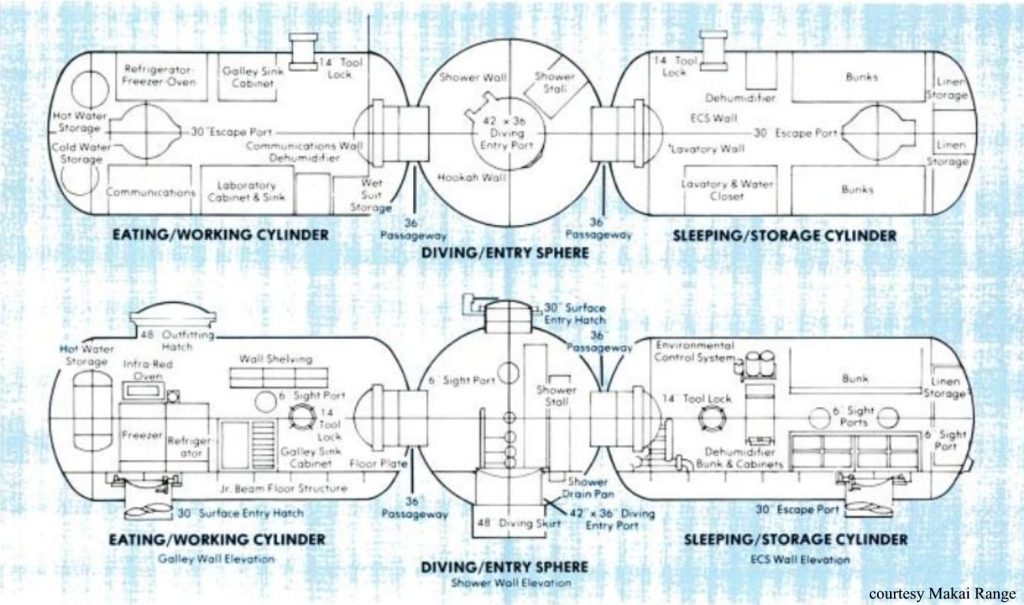
AEGIR 1971
The Aegir habitat was capable of supporting six divers at depths of up to 580 feed for as long as 14 days. The personnel chamber consisted of three compartments: living, control and laboratory. The living and laboratory compartments were identical in size and shape, cylindrical with dished heads and an inside dimension of 9 x 15 feet (2,7 x 4,6 meters). The control compartment, located between the two cylinders, was spherical, with an inside diameter of 10 feet (3 meters). The three compartments were connected by two 36 inch (91.4 centimetre) in diameter necks. The support platform (twin 70 foot (21.3 meter) long pontoons, each 9 feet (2.7 meters) in diameter) was capable of controlling the ascent and descent of Aegir independent of surface control.
A support ship tended the habitat when it was submerged. At the completion of a mission, the habitat was brought to the surface while the aquanauts remained in the pressurized compartment. The habitat was then towed to shore for completion of decompression.
Of the 65 habitats built since 1962, only one currently is used regularly. This is a small underwater classroom located on Key Largo in the Florida Keys. Designed and constructed as an engineering project at the United States Naval Academy in1974, this 8 x 16 foot (2.4 x 4.9 meters) habitat, now privately owned, is located in a mangrove lagoon at a depth of 20 feet (6.1 meters) and is used by students and researchers for missions lasting from 1 to 3 days. Normally occupied by 3 to 4 persons, the habitat has housed over 200 persons in the first 1 ½ years of operation. Because of the shallow depth, decompression is not required after missions are carried out.
NOAA later constructed a new habitat named the Aquarius for use at research sites throughout the Caribbean. This latest addition in the long line of habitats will operate at depths of up to 120 feet (36.6 meters) and will accommodate 6 scientist-aquanauts. Because of its mobility, the Aquarius can be moved to selected sites in response to the needs of scientific research.

HELIUM SATURATION DIVING U.S. NAVY DEEP OCEAN DIVE FILM AEGIR HABITAT 21624
This film about the Aegir project, MAKAI DEEP OCEAN DIVE was produced by the United States Navy in 1973. The film begins with remarks by astronaut and diver Scott Carpenter about Capt. George Bond, a U.S. Navy researcher who laid the groundwork for saturation diving with helium. Bond, who died in 1983, was an American physician who was known as a leader in the field of undersea and hyperbaric medicine and the “Father of Saturation Diving”. The film then shows some of the steps taken in the wake of Bond’s pioneering research in the deep sea. At 3:17 an open ocean dive is attempted off of Oahu. The year is 1971 and preparations are underway for a deep ocean dive in an underwater habitat using Underwater Breathing Apparatus. The rest of the film follows the progress of the experiment and the effects of the helium gas. The underwater platform used (seen at 6:45) was called the “Aegir” and was owned and operated by Makai Range, Inc. of Honolulu, Hawaii. AEGIR was designed to operate at depths of up to 180 meters. At 9:30, two tame porpoises that are also part of the team are seen. At 10:54, underwater open-ocean salvage techniques are practiced. At 12:27 the experiment begins with the steel hatch of the Aegir sealed and the compression begun with helium. At 14:20 compression is complete and the crew rests. At 15:00 the Aegir is towed out to sea so that it can be lowered to depth. At 17:00, the Aegir submerges. At 17:25, a freak accident causes the communication cable to be severed, and the Aegir is returned to the surface. At 22;30 the Aegir, now repaired, finally submerges to a depth of 200 feet, the ocean floor. At 23:20 divers are seen aboard the vessel in their Mark 10 diving suits. At 23:40 they leave the chamber and enter the open sea. At 25:30 divers return to the Aegir exhausted. Also featured in the film are interviews with LCDR Hugh Beatty, Ken Conda, Ben Cagle, James L.A. Majendie, Robert Helmriech, Ph.D., and Glen Egstrom, Ph.D. The film was written by Dr. Edward Hard Jr., who also wrote books under the pen name “T.W. Hard”. As you can see in the film, the Aegir consisted of two main modules joined in the middle by a sphere. It was one of the first habitats to include ballast tanks so it could raise and lower itself, whereas Sealab (for example) needed to be raised and lowered by crane. Aegir was deployed a number of times in various locations besides Hawaii such as Butler Bay, near St. Croix. It was planned to be Aquarius’ replacement when it was moved to Florida, but funding fell through, leading to the habitat being scuttled in 1973. Saturation diving is a diving technique that allows divers to reduce the risk of decompression sickness (“the bends”) when they work at great depths for long periods of time. Decompression sickness occurs when a diver with a large amount of inert gas dissolved in the body tissues is decompressed to a pressure where the gas forms bubbles which may block blood vessels or physically damage surrounding cells. This is a risk on every decompression, and limiting the number of decompressions can reduce the risk. “Saturation” refers to the fact that the diver’s tissues have absorbed the maximum partial pressure of gas possible for that depth due to the diver being exposed to breathing gas at that pressure for prolonged periods. This is significant because once the tissues become saturated, the time to ascend from depth, to decompress safely, will not increase with further exposure. In saturation diving, the divers live in a pressurized environment, which can be a saturation system or “saturation spread”, a hyperbaric environment on the surface, or an ambient pressure underwater habitat. This may be maintained for up to several weeks, and they are decompressed to surface pressure only once, at the end of their tour of duty. By limiting the number of decompressions in this way, the risk of decompression sickness is significantly reduced.
The film Makai deep Ocean dive is published on youtube by Periscope Films


Unfortunately, there is not much information left about the Aegir project. Every contribution with new information is welcome in order to record this project on the website. Your contribution is highly appreciated!

Therebreathersite was founded by Jan Willem Bech in 1999. After a diving career of many years, he decided to start technical diving in 1999. He immediately noticed that at that time there was almost no website that contained the history of closed breathing systems. The start for the website led to a huge collection that offered about 1,300 pages of information until 2019. In 2019, a fresh start was made with the website now freely available online for everyone. Therebreathersite is a source of information for divers, researchers, technicians and students. I hope you enjoy browsing the content!


















































































































































































